Court & Field Layout Reference Guide – Your Quick Playbook to Game-Ready Spaces
- Emily S
- Aug 12
- 2 min read

When it comes to sports, the magic doesn’t just happen in the heat of competition — it starts long before, in the way the court or field is designed. Every line, arc, and boundary has a purpose. In the Bison Sports 2025–2026 catalog, our Court & Field Layout Reference Guide brings you a visual snapshot of the playing surfaces for some of the world’s most popular sports.
These diagrams aren’t meant to replace official blueprints, but they’re the perfect way to get your bearings on how each game is set up. Whether you’re a facility manager, coach, athletic director, or sports enthusiast, having a quick reference for different layouts can be a game-changer.
What’s Inside the Guide
🏀 College BasketballFrom the 94' x 50' hardwood to the 22' 1¾" three-point arc, the diagram lays out every mark — center circle, free-throw lane, and restricted area — so you can see exactly where the action happens.
🏐 VolleyballAn indoor court measuring 59' x 29'6", divided by a central net, with attack lines 9'10" from the net. The guide also notes a minimum 6' clearance around the court to keep athletes safe and plays uninterrupted.
🏈 Football (11-player)The familiar gridiron with its 100-yard length, 10-yard end zones, yard lines, and hash marks. Team boxes and restricted areas are clearly indicated for smooth sideline management.
🤾 Team HandballA 131' x 66' playing area, with goal and free-throw lines set for fast-paced action. Substitution areas are marked along the sidelines for quick player swaps.
🏸 BadmintonSingles and doubles courts with different boundary lines, service boxes, and short/long service lines, making it easy to see where each rally begins.
🥒 PickleballThe 44' x 20' layout includes the non-volley zone (“kitchen”) and split service areas, showing exactly where this fast-growing game is played.
⚽ SoccerFrom the penalty area to the 6-yard box and center circle, the diagram maps out the world’s most popular game with pitch sizes ranging 100–130 yards in length.
🎾 TennisSingles and doubles lines, service boxes, and baselines are all accounted for, giving you a perfect visual for both competitive and recreational play.
🏖 Beach VolleyballA sand court measuring 52'6" x 26'3" without an attack line, with boundary lines clearly marked in the sand for open-air battles.
🏟 FutsalThe indoor cousin of soccer with a 131' x 66' surface, smaller goals, and tight penalty areas — perfect for high-energy, small-sided games.
🥎 Softball & BaseballFrom base path distances to pitcher’s mound placement, the diagrams show the diamond layouts for both sports, highlighting the key measurements for fair play.
Why This Matters
Having a quick visual guide for different sports is more than just handy — it’s essential for planning, teaching, and maintaining consistency across facilities. While the rulebooks hold the precise measurements, these reference diagrams let you compare layouts at a glance, helping you plan events, order the right equipment, and keep your players in the right place.
Bottom Line: Whether you’re setting up for tip-off, first serve, or kickoff, the Court & Field Layout Reference Guide gives you the big picture — so the game can run smoothly from the first whistle to the final buzzer.


Comments